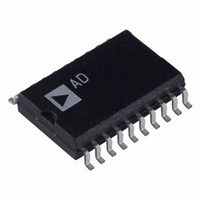AD800-52BRZ Analog Devices Inc, AD800-52BRZ Datasheet - Page 4

AD800-52BRZ
Manufacturer Part Number
AD800-52BRZ
Description
IC CLK\DATA RECOVERY PLL 20SOIC
Manufacturer
Analog Devices Inc
Type
Clock and Data Recovery (CDR)r
Datasheet
1.AD800-52BRZRL.pdf
(12 pages)
Specifications of AD800-52BRZ
Output
Differential
Frequency - Max
51.84MHz
Operating Temperature
-40°C ~ 85°C
Mounting Type
Surface Mount
Package / Case
20-SOIC (7.5mm Width)
Frequency-max
51.84MHz
Lead Free Status / RoHS Status
Lead free / RoHS Compliant
Voltage - Supply
-
Input
-
Available stocks
Company
Part Number
Manufacturer
Quantity
Price
Part Number:
AD800-52BRZ
Manufacturer:
ADI/亚德诺
Quantity:
20 000
AD800/AD802
The PLL must provide a clock signal which tracks this phase
modulation in order to accurately retime jittered data. In order
for the VCO output to have a phase modulation which tracks
the input jitter, some modulation signal must be generated at
the output of the phase detector (see Figure 21). The
modulation output from the phase detector can only be
produced by a phase error between the data input and the clock
input. Hence, the PLL can never perfectly track jittered data.
However, the magnitude of the phase error depends on the gain
around the loop. At low frequencies the integrator provides very
high gain, and thus very large jitter can be tracked with small
phase errors between input data and recovered clock. At
frequencies closer to the loop bandwidth, the gain of the
integrator is much smaller, and thus less input jitter can be
tolerated. The PLL data output will have a bit error rate less
than 1
specified jitter applied to it.
Jitter Transfer
The PLL exhibits a low-pass filter response to jitter applied to
its input data.
Bandwidth
This describes the frequency at which the PLL attenuates
sinusoidal input jitter by 3 dB.
Peaking
This describes the maximum jitter gain of the PLL in dB.
Damping Factor,
step. A greater value of corresponds to less overshoot in the
PLL response to a phase step. is a standard constant in second
order feedback systems.
Acquisition Time
This is the transient time, measured in bit periods, required for
the PLL to lock on input data from its free-running state.
USING THE AD800 AND THE AD802 SERIES
Ground Planes
Use of one ground plane for connections to both analog and
digital grounds is recommended. Output signal sensitivity to
power supply noise (PECL configuration, Figure 22) is less
using one ground plane than when using separate analog and
digital ground planes.
Power Supply Connections
Use of a 10 F tantalum capacitor between V
recommended.
Use of 0.1 F ceramic capacitors between IC power supply or
substrate pins and ground is recommended. Power supply
decoupling should take place as close to the IC as possible.
Refer to schematics, Figure 22 and Figure 26, for advised
connections.
Sensitivity of IC output signals (PECL configuration,
Figure 22) to high frequency power supply noise (at 2
nominal data rate) can be reduced through the connection of
signals AV
The type of bypass network to consider depends on the noise
tolerance required. The more complex bypass network schemes
tolerate greater power supply noise levels. Refer to Figures 23
and 24 for bypassing schemes and power supply sensitivity
curves.
describes how the PLL will track an input signal with a phase
10
CC
–10
and V
when in lock and retiming input data that has the
CC1
, and the addition of a bypass network.
EE
and ground is
the
–4–
Symmetry
Symmetry is calculated as (100
time equals the time that the clock signal is greater than the
midpoint between its “0” level and its “1” level.
Bit Error Rate vs. Signal-to-Noise Ratio
The AD800 and AD802 were designed to operate with standard
ECL signal levels at the data input. Although not recom-
mended, smaller input signals are tolerable. Figure 8, 14, and
20 show the bit error rate performance versus input signal-to-
noise ratio for input signal amplitudes of full 900 mV ECL, and
decreased amplitudes of 80 mV and 20 mV. Wideband ampli-
tude noise is summed with the data signals as shown in Figure
2. The full ECL and 80 mV signals give virtually indistinguish-
able results. The 20 mV signals also provide adequate perfor-
mance when in lock, but signal acquisition may be impaired.
Transmission Lines
Use of 50
CLKOUT, DATAOUT, and FRAC signals.
Terminations
Termination resistors should be used for DATAIN, CLKOUT,
DATAOUT, and FRAC signals. Metal, thick film, 1% tolerance
resistors are recommended. Termination resistors for the
DATAIN signals should be placed as close as possible to the
DATAIN pins.
Connections from V
OUT, FRAC, and CLKOUT signals should be individual, not
daisy chained. This will avoid crosstalk on these signals.
Loop Damping Capacitor, C
A ceramic capacitor may be used for the loop damping
capacitor.
Input Buffer
Use of an input buffer, such as a 10H116 Line Receiver IC, is
suggested for an application where the DATAIN signals do not
come directly from an ECL gate, or where noise immunity on
the DATAIN signals is an issue.
Figure 2. Bit Error Rate vs. Signal-to-Noise Ratio Test:
Block Diagram
DIFFERENTIAL
SIGNAL
SOURCE
transmission lines are recommended for DATAIN,
POWER
COMBINER
POWER
COMBINER
EE
SPLITTER
SOURCE
to lead resistors for DATAIN, DATA-
POWER
FILTER
NOISE
0.47 F
0.47 F
D
50
50
100MHz – AD802-155
33MHz – AD800-52
75
on time)/period, where on
GND
1.0 F
–5.2V
180
DATA IN
DATA IN
D.U.T.
AD800/AD802
REV. B














